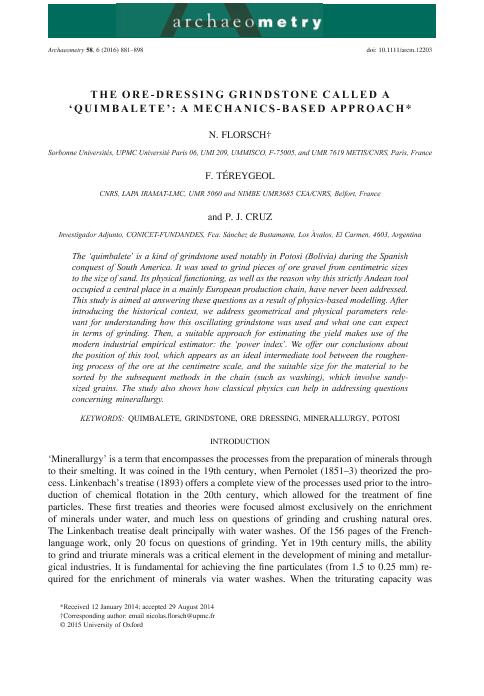Artículo
The Ore-Dressing Grindstone Called a ‘Quimbalete’: a Mechanics-Based Approach
Fecha de publicación:
12/2016
Editorial:
Wiley Blackwell Publishing, Inc
Revista:
Archaeometry
ISSN:
0003-813X
Idioma:
Inglés
Tipo de recurso:
Artículo publicado
Clasificación temática:
Resumen
The ‘quimbalete’ is a kind of grindstone used notably in Potosi (Bolivia) during the Spanish conquest of South America. It was used to grind pieces of ore gravel from centimetric sizes to the size of sand. Its physical functioning, as well as the reason why this strictly Andean tool occupied a central place in a mainly European production chain, have never been addressed. This study is aimed at answering these questions as a result of physics‐based modelling. After introducing the historical context, we address geometrical and physical parameters relevant for understanding how this oscillating grindstone was used and what one can expect in terms of grinding. Then, a suitable approach for estimating the yield makes use of the modern industrial empirical estimator: the ‘power index’. We offer our conclusions about the position of this tool, which appears as an ideal intermediate tool between the roughening process of the ore at the centimetre scale, and the suitable size for the material to be sorted by the subsequent methods in the chain (such as washing), which involve sandy‐sized grains. The study also shows how classical physics can help in addressing questions concerning minerallurgy.
Palabras clave:
Grindstone
,
Minerallurgy
,
Ore Dressing
,
Potosi
,
Quimbalete
Archivos asociados
Licencia
Identificadores
Colecciones
Articulos(SEDE CENTRAL)
Articulos de SEDE CENTRAL
Articulos de SEDE CENTRAL
Citación
Florsch, N.; Téreygeol, F.; Cruz, Pablo; The Ore-Dressing Grindstone Called a ‘Quimbalete’: a Mechanics-Based Approach; Wiley Blackwell Publishing, Inc; Archaeometry; 58; 6; 12-2016; 881-898
Compartir
Altmétricas




